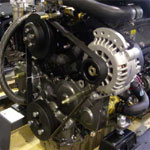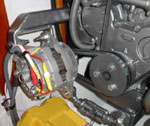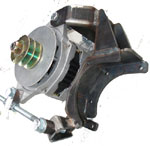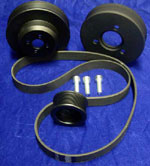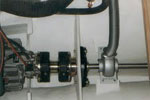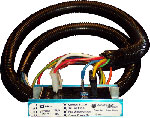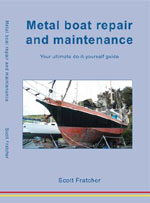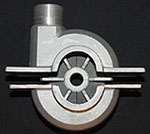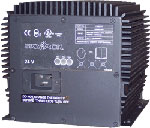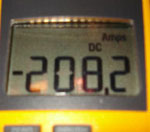Technician Engine Analysis Checklist
By: Scott
Fratcher - Marine Engineer/Captain
An engine analysis is an advanced system of inspecting our boats
drive train. We perform these tests to help catch pending mechanical
issues before we leave the dock. An analysis is much more comprehensive
than a typical “pre-departure peak” at the engine. We are
going to not only visually inspect our engine, but also take a series
of measurements that become our baseline for future tests. Our goal
is use this engine analysis as a system to help make easy informed decisions
about our boats drive system.
To begin you should have on-hand as much of the following as possible:
- · Camera
- · Notepad
- · Your collection of electrical meters
- · A 0-3 bar pressure gauge (if your engine has a turbo)
- · An infer red temperature gauge
- · Any other special tools you might have
- · A few rags, and spray cleaner
The steps to performing an engine analysis:
1. Visual inspection
2. Pre inspection
3. Bollard pull
4. Analyzing the numbers
Visual inspection
This is a general once over of the engine looking for blatant flaws.
Open the engine room door, look, feel and smell
Look for oil drips or other fluid under the engine. Inspect for obvious
cracked hoses. Give a gentle bend where a hose attaches to the engine
and look for cracks in the rubber cover. Check the fan belts for cracks
and loose hose clamps. Grab the alternator pulley and see if it will
spin free on the belt. If it does then the belt is worn or loose.
Feel the inside of the engine room for oil film. Touch the areas of
the engine you can’t see feeling for rust or salt trails.
Smell for any burned chemical type odor. Smells can be difficult to
locate, but in general any burnt, oily, or diesel smells should be searched
out. A good nose can tell the difference between a hot belt and a hot
wire.
Look over the complete engine for oil leaks. Pay particular attention
to the front seal, and the area between the gearbox and engine. Leaks
in the front or rear seal can mean a coming engine rebuild. Inspect
the head to block connection looking for oil or water trails.
Take photos from all angles as a base line for later use.
This is the point where many an engine inspection ends, but in an analysis
we want better scrutiny to help build confidence in our propulsion system.
Our next series of checks focus on fluid inspections
Oil
Oil is the lifeblood of our engine. It lubricants, cools and quiets
our engine. But how do we know if the oil is doing its job?
Begin by pulling the dipstick. Smell for signs of diesel odor. Pinch
a small dab of oil between your index finger and thumb and expand slowly
to see how far you can spread the oil before the gap opens. Compare
this gap to new oil and take down the difference for your notes. This
is a crude method of checking viscosity and diesel intrusion.
Open the oil fill and look inside the cap for water droplets, condensation
or worse, a gray gooey substance indicating water penetration into the
oil. Put a small drop of oil on a paper towel and compare it to a new
oil drop. Note the amount of black carbon and any shiny deposits.
A more careful inspection can include an inside look at the oil filter.
Next time you change oil keep the old filter. Leave it to drain upside
down then cut open the canister and look at the inside of element. It’s
the inside that will contain any heavy deposits or worse, metal shavings.
Take photos for later comparison.
Immediately after start up note the oil pressure and again during our
bollard pull test and lastly immediately upon reducing throttle after
our bollard pull test. Does the gauge needle dip? It should remain steady
from start up and through all the following tests. A dipping gauge can
indicate a faulty pressure release, or worse, worn engine bearings.
Coolant
A typical yacht engine has two cooling water loops, fresh water and
raw water. Lets look at the fresh water loop first.
Open the expansion tank cover or the heat exchanger cover or where
you check the coolant water. The reservoir should be filled almost to
the top with coolant. A low coolant level can mean a small air leak
in a hose.
Check the coolant for oil. It should look new and fresh. The underside
of the cap should be clean. NO brown gooey oil should be present under
the cap. Any strange colors can mean a failing heat exchanger or failing
head gasket or bad heat exchanger.
Our salt water system we’ll check by measuring flow rate and
using our laser temperature gauge to measure efficiency.
Diesel Filter
Locate your diesel filters. Most boats have two sets, one on the engine
supplied by the manufacturer and a set of pre-filters. On the bottom
of most any fuel filter will be a drain valve. Drain off a small amount
of fuel into a container checking for water, dirt and any long stringy
algae. If you find more than a couple teaspoons of water or much dirt
then it’s probably time to change the filters. If your filter
system has a vacuum gauge then note the readings in the log for future
comparison.
Engine control system inspection
The engine control system is what directs our intentions to the engine
and they are one of the most important inspections you will make. If
the engine fails to engage in reverse during docking the results can
be boat damage or worse.
Begin by feeling for play in the shifting linkage. Move the controls
through all possible motions feeling for “hard” spots. Does
neutral have a detent or “click” to tell the helmsman he
is in neutral?
Inspect where the cables attach inside the shifting housing. Look at
each split pin for wear. Wiggle and physically inspect each connection
looking for cracks, breaks, or anything that looks amiss. Pay particular
attention to where the cable cover end attaches to the shift housing.
If this point slips we will loose engine control immediately.
Move to the engine and check the same cable ends, but this time also
searching for chafe from engine vibration. An area where the plastic
cable cover has chafed through can let in small amount of water corroding
our cable in areas we can’t see causing an unpredictable loss
of engine control.
Gearbox and coupling
Inspect the gearbox to prop shaft flange bolts. Attempt to tighten
the Allen setscrews. Loose bolts or setscrews indicate a vibration or
miss alignment. Pull the gear oil dipstick. Check level and perform
our viscosity check again. Look for water under the cap and smell for
any burned odor. Most yacht gearboxes don’t have a filter so any
bits of crud or metal keep getting recalculated so it is imperative
we keep an eye on the oil.
Bollard Pull Test
The next series of test duplicate our engine working under load. Were
going to pull against our dock lines while safely tied in the marina
so can perform a series of inspections. This test can also be performed
at anchor if the boat is run hard in reverse or while underway.
Note-It is imperative to inspect the dock lines, anchors, and cleats
for suitability for such loads. Double up your spring lines and inspect
the dock cleats. If you are testing a larger or higher horsepower yacht
consider getting underway for this test.
Tip-Locate the manual shut down on the injection pump and be ready
to shut the engine down if you suspect any problems or hear shouting.
Start up check
Start the engine; wait a couple seconds for oil pressure to build.
Were gong to start our tests by checking alternator output. We perform
this test early while the alternator is still at full output.
Increase rpm’s to 1000. Set your clamp amp to DC and place the
jaws around the positive/red cable at the back of the alternator. Check
the output and note the DC reading. Change the meter to AC and again
note the reading. The AC reading should be around three amps. If the
AC reading is near half of the DC reading this indicates a faulty diode.
Come back at the end of testing and verify the voltage has stabilized
around 14.2 volts.
Seawater flow test
While the engine continues to warm up increase throttle to about 2000
rpm’s in neutral. Take a bucket to the engine exhaust and time
how long it takes to fill. This number will come in handy if you ever
suspect a failing impeller, clogging raw water loop, or clogged exhaust
riser.
Begin our strain test
Wait for the engine to warm up (maybe five to ten minutes). Put the
engine in forward (reverse if this is a test at anchor). Slowly bring
the engine up to half throttle. Check all the dock lines one more time.
If all the lines and cleats appear strong then increase the engine to
full throttle. Note the maximum rpm’s obtainable. If you have
a handheld tachometer then compare the engine results to the helm gauge.
Note any difference so later you can make an rpm correction table.
After maximum rpm’s have been reached reduce them by 200 for
testing. For example a typical Yanmar might have a max rpm’s of
3600, but would only reach 3400 pulling against the dock lines thus
should be run at 3200 rpm’s for the remaining load tests. This
way we are running the engine hard, but not overloaded.
Look at the engine mounts. They will be taking the thrust of the engine
and should be compressed forward. Inspect them for any indication they
are “rolling out” indicating a coming failure. Even under
strain the rubber mounted studs should still sit vertical. Look for
metal-to-metal contact in the base.
Note-At the end of the bollard pull test run the engine hard in reverse
and come back and check the mounts one last time. Take photos of both
forward and reverse thrusting mounts for later comparison.
Smoke?
As the engine comes up to full temperature you might see signs of smoke.
Determine if the smoke is escaping from the engine or if we are simply
“gassing” off an old oil/dirt film. Pay particular attention
for smoke escaping from between the engine and exhaust manifold. This
may be combustion gas that could contain carbon monoxide Carbon monoxide
is a dangerous, colorless, odorless gas that can kill when released
into confined spaces.
Move to the back of the engine. Take a good look at the shaft to gearbox
coupling. It should be sitting almost perfectly smooth. Any pumping
for and aft motion could indicate failing engine mounts. A circular
motion could be a bent shaft, out of align engine, or possibly damaged
prop.
Look at the packing gland for the amount of water dripping past the
shaft into the boat. Compare this to the manufacturers recommendation.
Be sure to note the amount of drips over a sixty second period and write
this in the ship’s log as it’s a common point for crew to
worry about.
Temperature tests
By now the complete engine should be stabilized at temperature. It’s
time to do a few tests with our laser temp gauge. If you have not used
a laser temperature gauge before you’ll be amazed at how much
information this simple tool will show us about our engine. (See Tradeaboat
April for full use instructions)
Begin by scanning the gearbox looking for hot spots. Pay careful attention
to the area of the case around the clutch packs, and the gearbox output
bearing. If any part of the gearbox is going to build up heat it will
be during this bollard pull test. The complete gearbox should be under
80C, and 60C is typical.
Continue checking with the laser gauge along the cylinder head. It
should show about 75-85C everywhere. There should be no hot spots. A
hot spot would be more than a five degree C change in the head from
one end to the other.
Note-Testing the area directly around the exhaust manifold does not
count as a “hot spot”, as this will be hot due to the high
temperature of the exhaust.
Check the oil temperature by shooting the oil filter or oil pan. The
oil temp should be about 7-10C above the head temperature and not above
95C.
Check the inlet to the salt-water pump and outlet of the final heat
exchanger. With most engines the temperature difference should be less
than 10C. A higher temperature difference can indicate an engine producing
too much heat (IE failing head gasket) or too little water flow (IE
clogged salt water system).
Check the fresh water temperature inlet and outlet of the heat exchanger.
The difference should be about 10C and stable. You should be able to
move the laser along the body of the heat exchanger and show the cooling
effect of the heat exchanger. By this method you can see how much reserve
cooling you have left in the heat exchanger.
The pre turbo exhaust temperature should be about 300-450C. After turbo
it should be a bit lower. Check the exhaust gas temp between the cylinders
and exhaust manifold for each cylinder. Normal for a loaded non-turbo
engine should be 300C. A cylinder temp lower than the rest shows a clogged
injector or maybe a dead cylinder. A high cylinder temp possibly shows
a leaking exhaust valve, or poor injector spray pattern.
Crankcase pressure?
Locate the crankcase ventilation hose and feel the outlet for crankcase
pressure. If your engine does not have an easily accessible vent line
you can also check for crankcase pressure at the oil fill. Slowly open
the oil fill and check for “blow by.” Blow by is a the amount
of gas and oil mist that seeps by the piston rings and pressurizes the
crankcase. Excessive blow by can mean worn out rings. You should not
feel any pressure in the oil fill. Testing with a gauge should not show
above a pound of pressure.
Note-Be careful opening the oil fill, this may release little hot oil
droplets being thrown off the rocker arms.
Turbo test
If the engine has a turbo, find a port on the intake manifold and check
the pressure. Compare this to the manual. Many turbo boost up to 2 bars.
Most Yanmar engines boost to 1.1 bar. The pressure should be stable.
Any cycling of pressure, or “coughing” can indicate after
burning, blow-by, or clogged air inlet.
Reduce throttle tests
Take one last look for any signs of future problems and slow the engine
down to an idle. Check with the laser temp to see if the engine cools
quickly (less than 5 minutes).
Verify the alternator is producing 14.2 volts. Less means the voltage
regulator needs to be inspected, and more may mean we are cooking the
batteries causing early failure.
Shut the engine down.
Load test starter
Place the jaws of the clamp amp over the positive cable leading to
the starter. Clip your voltmeter to the starter’s positive and
negative. Hold the STOP button, or manual engine shutdown and then turn
the engine over for ten seconds. (The engine should not start.) Note
the amp draw.
On a typical 40-75 hp engine the reading should be 225-275 amps. Look
at the starter for a rated amperage or wattage. (Watts/volts=Predicted
amps. They should match) anything more indicates poor cables, a bad
armature in the starter, or failing batteries. The voltage during this
test should remain above 9.5 volts. The results of this test should
be placed in the vessel log for future reference. This is an important
test as it indicates if the starter is about to fail and helps trouble
shoot later problems.
Pull the air filter and inspect for cleanliness. Reach a finger down
the air inlet. It should be lightly covered in dirty oil. Any loose
oil or splatter indicates a possible faulty inlet valve, or maybe a
turbo failing.
If the engine has a turbo charger you might be able to reach inside
and give the blades a spin. They should move easily with no restrictions,
or any “bumps”.
Conclusion
For most boties an in-depth inspection of the vessels drive system
can mean more confidence, safer travel and a much easier time of finding
trouble spots in the future.
Remember to keep careful records of all the tests performed so in the
future when something has changed we can repeat the tests making short
work of the trouble shooting and quickly get back to enjoying the water.
Adapted from “How To Make Money With
Boats”
|

